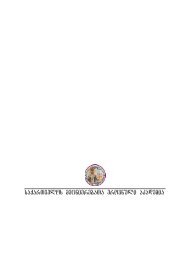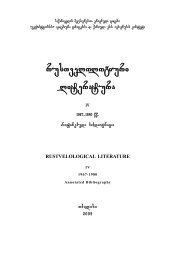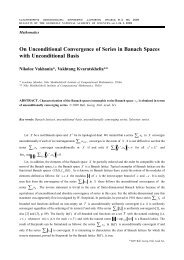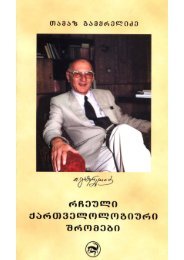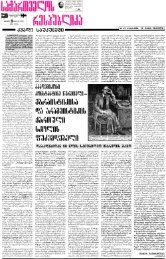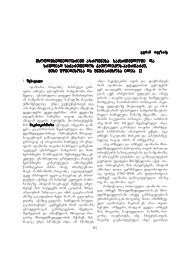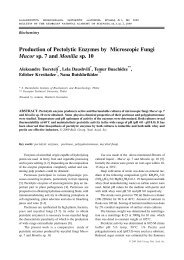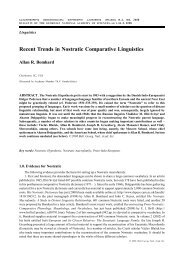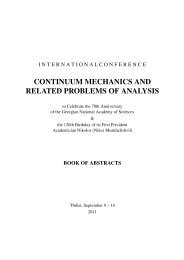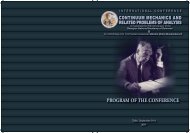The Indo-European Homeland in the Near East: New Evidence
The Indo-European Homeland in the Near East: New Evidence
The Indo-European Homeland in the Near East: New Evidence
You also want an ePaper? Increase the reach of your titles
YUMPU automatically turns print PDFs into web optimized ePapers that Google loves.
saqarTvelos mecnierebaTa erovnuli akademiis moambe, t. 175, #3, 2007<br />
BULLETIN OF THE GEORGIAN NATIONAL ACADEMY OF SCIENCES, vol. 175, no. 3, , 2007<br />
Humanities & Social Sciences<br />
History & Philology<br />
<strong>The</strong> <strong>Indo</strong>-<strong>European</strong> <strong>Homeland</strong> <strong>in</strong> <strong>the</strong> <strong>Near</strong> <strong>East</strong>:<br />
<strong>New</strong> <strong>Evidence</strong><br />
Vyacheslav V. Ivanov *<br />
* University of California, Los Angeles, USA<br />
ABSTRACT. <strong>The</strong> problem of <strong>the</strong> <strong>in</strong>itial place from which <strong>the</strong> orig<strong>in</strong>al <strong>Indo</strong>- <strong>European</strong> dialects spread over <strong>the</strong><br />
West part of Eurasia has been studied by several generations of scholars. Few alternative po<strong>in</strong>ts of view have been<br />
proposed: first an area near <strong>the</strong> North Sea (<strong>in</strong> <strong>the</strong> works of some scholars of <strong>the</strong> turn of <strong>the</strong> XIX and XX centuries),<br />
<strong>the</strong>n <strong>the</strong> North coast of <strong>the</strong> Black Sea (an old idea of Schrader revived by Maria Gimbutas and her followers 1 ).<br />
35 years ago <strong>the</strong> author of <strong>the</strong> present text toge<strong>the</strong>r with Tamaz Gamkrelidze suggested first <strong>in</strong> a talk at a<br />
conference, <strong>the</strong>n <strong>in</strong> a series of articles and <strong>in</strong> a result<strong>in</strong>g book that <strong>the</strong> South-<strong>East</strong> part of Anatolia, close to North-<br />
<strong>East</strong> Syria and North area of Mesopotamia, may be considered as a possible candidate for <strong>the</strong> <strong>Indo</strong>-<strong>European</strong> homeland,<br />
Gamkrelidze, Ivanov 1972; 1995, 1990; see map 1 of <strong>the</strong> possible migrations suggested <strong>in</strong> <strong>the</strong> latter publication<br />
and reproduced below.<br />
S<strong>in</strong>ce that time many l<strong>in</strong>guists, archeologists and specialists <strong>in</strong> <strong>the</strong> o<strong>the</strong>r fields of studies bear<strong>in</strong>g on <strong>the</strong><br />
solution of this question have been discuss<strong>in</strong>g <strong>the</strong> arguments for and aga<strong>in</strong>st this suggestion. Recent research on<br />
<strong>the</strong>se topics has brought additional evidence that seems to prove <strong>the</strong> <strong>Near</strong> <strong>East</strong>ern hypo<strong>the</strong>sis <strong>in</strong> a def<strong>in</strong>ite way. <strong>The</strong><br />
article sums up <strong>the</strong> results achieved <strong>in</strong> <strong>the</strong> last decades.© 2007 Bull. Georg. Natl. Acad. Sci.<br />
Key words: Proto-<strong>Indo</strong>-<strong>European</strong>, <strong>Indo</strong>-<strong>European</strong> homeland.<br />
1. Contacts of Proto-<strong>Indo</strong>-<strong>European</strong> with o<strong>the</strong>r l<strong>in</strong>guistic<br />
families. <strong>Indo</strong>-<strong>European</strong> elements <strong>in</strong> Kartvelian.<br />
Indirect evidence on <strong>the</strong> early presence of <strong>Indo</strong>-<strong>European</strong>s<br />
<strong>in</strong> <strong>the</strong> areas close to <strong>the</strong> <strong>Near</strong> <strong>East</strong> can be found <strong>in</strong><br />
<strong>the</strong> traces of <strong>the</strong> ancient contacts between l<strong>in</strong>guistic families<br />
<strong>in</strong> this part of Eurasia. Such contacts between Proto-<br />
<strong>Indo</strong>-<strong>European</strong> and Proto-Kartvelian have been sug-<br />
<br />
more than 40 years ago. <strong>The</strong> follow<strong>in</strong>g studies have established<br />
a number of important loanwords from Proto-<br />
<strong>Indo</strong>-<strong>European</strong> <strong>in</strong> Proto-Kartvelian. Particularly <strong>in</strong>terest<strong>in</strong>g<br />
discoveries <strong>in</strong> this field were made by <strong>the</strong> late<br />
1<br />
See <strong>the</strong> chapter on Place and Time <strong>in</strong> <strong>the</strong> new textbook:<br />
Mallory- Adams 2006, pp. 86-105.<br />
G.A.Klimov 2 . He has found many new common elements<br />
of <strong>the</strong> two families <strong>in</strong> addition to a relatively long list <strong>in</strong><br />
our jo<strong>in</strong>t work with Gamkrelidze <strong>in</strong> which we <strong>in</strong>cluded<br />
also <strong>the</strong> correspondences earlier noticed by Klimov. <strong>The</strong><br />
ma<strong>in</strong> difficulty <strong>in</strong> <strong>in</strong>terpret<strong>in</strong>g <strong>the</strong> results of his <strong>in</strong>vestigations<br />
is connected to <strong>the</strong> problem of a possible common<br />
Nostratic orig<strong>in</strong> both of Proto-<strong>Indo</strong>-<strong>European</strong> and of<br />
Proto-Kartvelian. If <strong>the</strong>se two l<strong>in</strong>guistic families were orig<strong>in</strong>ally<br />
cognate, <strong>the</strong>n some part of <strong>the</strong> correspondences<br />
found by Klimov and o<strong>the</strong>r scholars might have been<br />
traced back to <strong>the</strong> Proto-Nostratic early period 3 (more<br />
2<br />
Klimov 1985-1998; Klimov, Khalilov 2003; cf. also Harris<br />
1990, Grepp<strong>in</strong> 1997.<br />
3<br />
<strong>The</strong> question was put forward already <strong>in</strong> : Shevoroshk<strong>in</strong><br />
1986.<br />
© 2007 Bull. Georg. Natl. Acad. Sci.
128 Vyacheslav V. Ivanov<br />
Map 1. <strong>The</strong> <strong>Indo</strong>-<strong>European</strong> homeland and proposed migrations (after Gamkrelidze and Ivanov 1990).<br />
than 10 000 years ago). Only those words that were not<br />
<strong>in</strong>herited from this ancient time are important as a proof<br />
of <strong>the</strong> later existence of Proto-<strong>Indo</strong>-<strong>European</strong> <strong>in</strong> <strong>the</strong> area<br />
close to <strong>the</strong> Proto-Kartvelian (to <strong>the</strong> South-West of <strong>the</strong><br />
Transcaucasian area <strong>in</strong> which <strong>the</strong> latter spread <strong>in</strong> <strong>the</strong> historic<br />
time, Klimov 1998, pp. IX, XII). In a recent work of<br />
<strong>the</strong> late S.A. Starost<strong>in</strong> who has tried to select <strong>Indo</strong>-<strong>European</strong><br />
elements <strong>in</strong> Kartvelian dist<strong>in</strong>guish<strong>in</strong>g <strong>the</strong>m from <strong>the</strong><br />
possible common Nostratic core several def<strong>in</strong>ite comparisons<br />
have been s<strong>in</strong>gled out such as: Proto-Kartvelian<br />
borrowed <strong>in</strong> <strong>the</strong><br />
o<strong>the</strong>r Kartvelian languages, Klimov, Khalilov 2003, p. 146)<br />
: <strong>Indo</strong>-<strong>European</strong> dialectal *ankos- 4 (Avestan aka<br />
5 , Sanskrit a ká-, a <br />
uncus<br />
angul <br />
Kartvelian *tel- tel-<br />
<br />
4<br />
In Kartvelian this relatively recent borrow<strong>in</strong>g is reflected<br />
without a laryngeal which is seen <strong>in</strong> <strong>the</strong> o<strong>the</strong>r probable Nostratic<br />
correspondences of <strong>Indo</strong>-<strong>European</strong> stems. If one does not accept<br />
<strong>the</strong> Nostratic hypo<strong>the</strong>sis <strong>the</strong>n it is still necessary to dist<strong>in</strong>guish<br />
2 different strata of <strong>Indo</strong>-<strong>European</strong> borrow<strong>in</strong>gs: with-<br />
<br />
and with <strong>the</strong>m, cf. forms like Kartvelian * web<br />
Huebh-, Kartvelian *ãwed-<br />
<br />
H]wedh<br />
pp. 74-75; 1994b; 1998, p. 225).<br />
5<br />
<strong>The</strong> archaic mean<strong>in</strong>g preserved <strong>in</strong> Old Iranian might help<br />
to understand <strong>the</strong> reasons for <strong>the</strong> borrow<strong>in</strong>g of a technical<br />
term.<br />
6<br />
Starost<strong>in</strong> 2007, pp. 818-819, cf. on o<strong>the</strong>r (mostly older)<br />
common elements <strong>in</strong> <strong>Indo</strong>-<strong>European</strong> and Karvelian also ib.,<br />
pp. 807-815.<br />
ano<strong>the</strong>r one discovered much earlier: dialectal Kartvelian<br />
* or<br />
dialectal <strong>Indo</strong>-<strong>European</strong> * horyo-<br />
Ivanov 1995); Proto-Kartvelian *usxo-<br />
Proto-<strong>Indo</strong>-<strong>European</strong> uk w so- (Klimov 1994a; 1998,<br />
pp.195-196) and o<strong>the</strong>r words 6 . <strong>The</strong>se borrow<strong>in</strong>gs po<strong>in</strong>t<br />
to certa<strong>in</strong> spheres of <strong>the</strong> economy and farm<strong>in</strong>g technology<br />
(cf. such clear examples as, for <strong>in</strong>stance, : Kartvelian<br />
*berg<br />
pean *bh(e)r-g-[], Klimov 1994, pp. 49-50; 1998,<br />
p. 11) that were more developed <strong>in</strong> <strong>the</strong> society from <strong>the</strong><br />
language of which <strong>the</strong> nouns had been borrowed.<br />
2. Proto-<strong>Indo</strong>-<strong>European</strong> and Proto-North Caucasian.<br />
In our book published <strong>in</strong> 1984 we suggested some common<br />
terms shared by <strong>the</strong>se languages expla<strong>in</strong><strong>in</strong>g <strong>the</strong>m as<br />
possible traces of later <strong>Indo</strong>-<strong>European</strong> (probably <strong>Indo</strong>-<br />
Iranian) migrations through <strong>the</strong> Caucasus. <strong>The</strong> study of<br />
this problem has been enriched through <strong>the</strong> recent research<br />
on Proto-North Caucasian. S.L. Nikolaev and S.A.<br />
Starost<strong>in</strong> have compiled a large etymological dictionary<br />
of this family (Nikolaev, Starost<strong>in</strong> 1994) develop<strong>in</strong>g <strong>the</strong><br />
comparative studies started by <strong>the</strong> Pr<strong>in</strong>ce<br />
N.S.Trubetzkoy 7 . Starost<strong>in</strong> has ga<strong>the</strong>red a large collection<br />
of <strong>the</strong> terms of material culture common to North<br />
Caucasian and <strong>Indo</strong>-<strong>European</strong> (Starost<strong>in</strong> 2007, pp. 310,<br />
312-358, 818). <strong>The</strong>y <strong>in</strong>clude many names of domestic animals<br />
(Proto North Caucasian *hînèwe 8 ; *?çjþwe<br />
7<br />
Trubetzkoy 1987 (with important comments on North<br />
Caucasian by S.A.Starost<strong>in</strong>, pp.437-447; 453-465).<br />
8<br />
<strong>The</strong>re are at least two more North Caucasian words for<br />
horse that might be compared to dialectal <strong>Indo</strong>-<strong>European</strong> terms<br />
polo-s is<br />
found only <strong>in</strong> some dialects but still belongs to a relatively old<br />
part of technical vocabulary s<strong>in</strong>ce it is attested <strong>in</strong> Mycenaean<br />
Bull. Georg. Natl. Acad. Sci. vol. 175, no. 3, 2007



